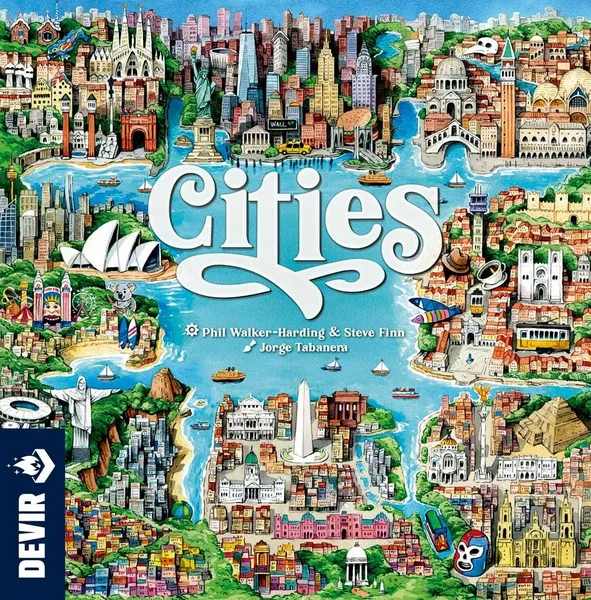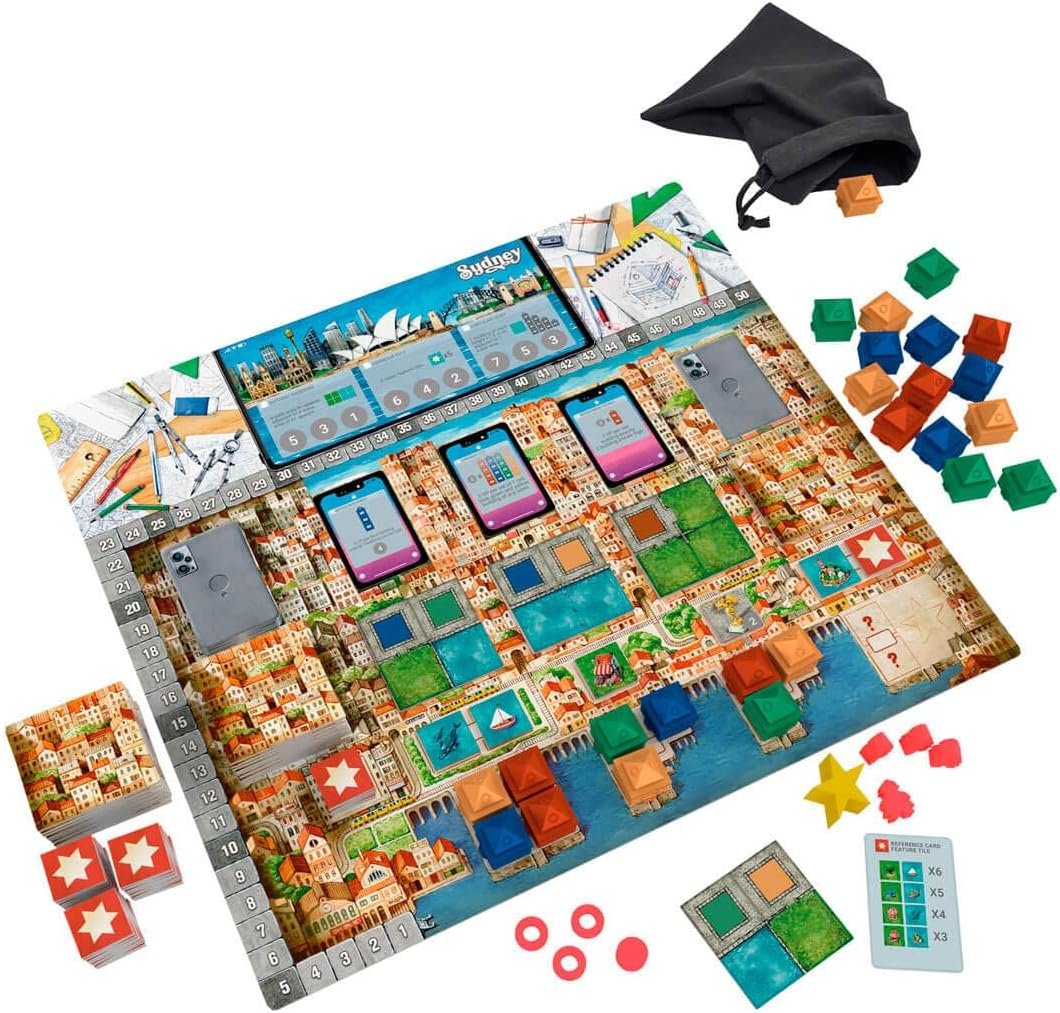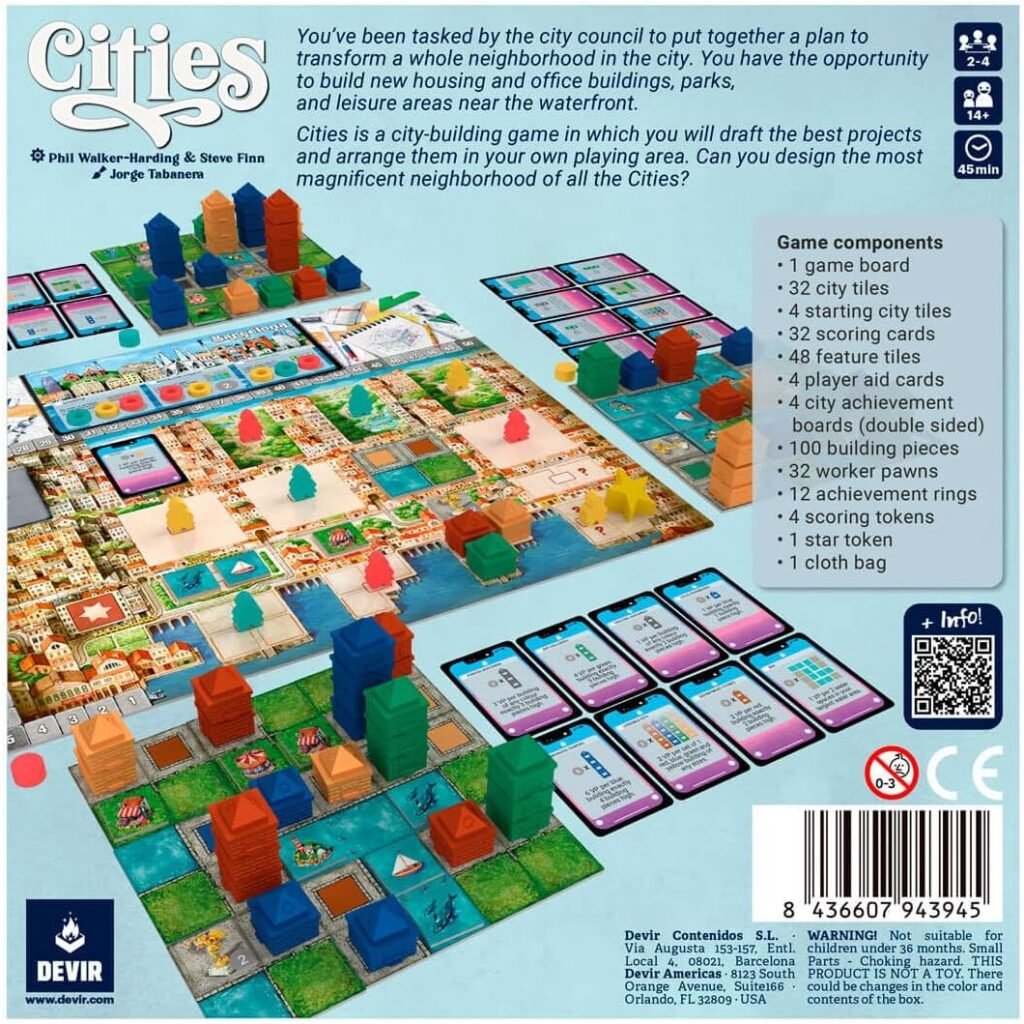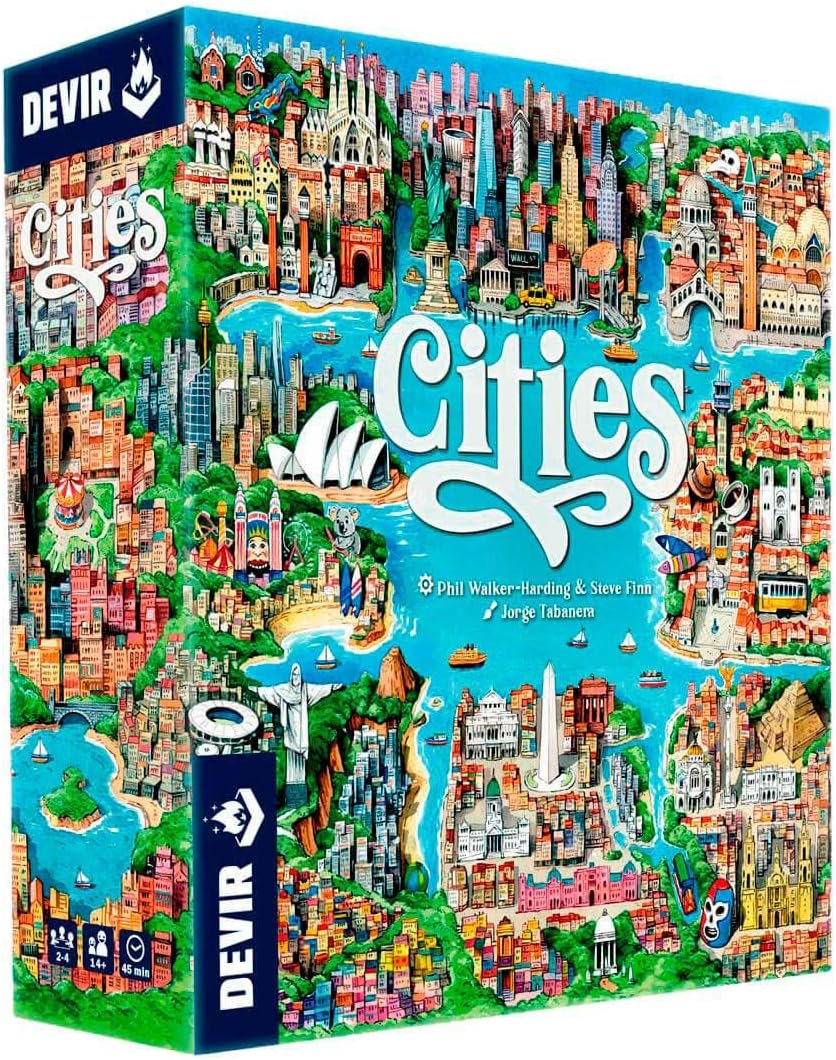
Today we’re diving into “Cities.” This is a city-building board game designed by Phil Walker-Harding & Steve Finn, two designers known for their lighter games. So, let’s break it down – what it is, what’s good, what’s bad, & if you should pick it up. Let’s get into it.

What It Is
“Cities” is a city-building board game for 2-4 players, designed by Phil Walker-Harding, famous for games like Sushi Go, & Steve Finn, known for Biblios. Over the course of 8 rounds (4 rounds in a 2-player game), players work to construct their own metropolis. Each player starts with a color, four workers (or eight in a 2-player game), & a starting tile. The main board features multiple rows from which players will draft different elements to build their city, including scoring cards, large city tiles, smaller building tiles, & the option to draw random buildings from a bag.
Gameplay Overview
In Cities, players step into the role of city planners, aiming to craft the most impressive urban landscape. Using workers, players draft city tiles, features, & building sets to create their city blocks, all while collecting scoring cards that highlight the most picturesque features. The game challenges players to strategically assemble their cities, competing to achieve the highest score by the end of the game.
The game setup involves laying out the main board & selecting one of the double-sided city tiles, with New York or Rio de Janeiro recommended for beginners. These tiles represent common objectives that all players will race to achieve. Players shuffle the scoring cards, city tiles, & feature tiles, then arrange the game components in their designated spaces on the board. Each player chooses a color, places their score marker on the track, & takes their workers & rings, ready to start building their city.
Cities is played over eight rounds in a three- or four-player game. At the beginning of each round, a market of tiles & cards is set up for players to draft from. Players take turns placing their workers on one of the available spaces, selecting tiles, cards, or buildings, which they must immediately integrate into their growing city. A key rule is that players cannot place a worker in a row where they already have one, ensuring a variety of choices throughout the round.
As players draft, they must carefully place city tiles adjacent to previously placed tiles, ensuring their city fits within a 3×3 grid by the end of the game. Feature tiles, such as parks & water, are placed into matching colored blocks, with specific placement rules that influence scoring. Building pieces are stacked on matching colored squares, but can only reach a maximum height of four. Strategic placement is crucial, as it affects both immediate objectives & end-game scoring.
Throughout the game, players compete to achieve the objectives printed on their starting city tiles. When a player meets an objective, they mark it with one of their rings & score points. The race to complete these objectives first adds a competitive edge to the gameplay. Each round ends when all players have placed their workers, & new tiles & cards are dealt for the next round.
After eight rounds, players score their cities based on various factors, including the placement of monuments, the diversity of features in park & water areas, & the combinations of buildings as indicated on their scoring cards. Each monument tile scores two points, & feature areas score based on the number of different types within them. Players then add points from their scoring cards & city objectives, & the player with the highest score wins.
In the two-player version of the game, the draft mechanics are slightly altered. Each player uses eight workers instead of four & takes two items from each row per round, allowing for a different strategic dynamic. The game can be played in either a standard four-round format or a longer seven-round variant, with players finishing with a 3×5 grid instead of 3×3.
Cities offers a blend of strategic planning, competitive drafting, & city-building, making it a challenging & engaging experience. Whether you’re playing with a group or head-to-head, the game provides ample opportunities for strategic depth & creative city design.
The Components
The components of “Cities” are generally well-produced, though there are some issues with color differentiation that could be problematic for colorblind players, especially with the red & green pieces. The artwork has a charming, slightly dated feel that evokes travel & city planning. However, the scoring cards, designed to look like smartphone screens, feel somewhat out of place with the rest of the aesthetic, lacking the warmth & whimsy found in other elements of the game.
The Good
“Cities” excels at providing players with a series of small but meaningful decisions. The drafting mechanism is well-implemented, creating tension as players try to balance getting what they need while denying opponents key pieces. The variable city boards add replayability & help tie the scoring objectives together thematically. Each city comes with its own set of three scoring objectives that are designed to work together & reflect the character of that particular city.
The game plays quickly & is easy to teach, making it accessible to a wide range of players. The quick turns & constant engagement keep players involved throughout the game. It shines with 3 or 4 players, where the competition for resources creates more tension than in the 2-player variant.

The Bad
Despite its strengths, “Cities” does have some drawbacks. The gameplay can become repetitive over the course of 8 rounds, especially for those who are used to more dynamic city-building games. The end-game scoring can also feel a bit disconnected at times, as players accumulate scoring cards that don’t always synergize well together, leading to situations where you’re torn between pursuing different scoring strategies.
Additionally, the color differentiation issues with the components could be a significant downside for colorblind players, particularly with the red & green pieces.
The Verdict
So, should you buy “Cities”? If you’re a fan of lighter strategy games or enjoy spatial puzzles with a city-building theme, then “Cities” is likely to appeal to you. It offers engaging gameplay with just enough depth to keep players invested, & its ease of teaching & quick playtime make it a strong candidate for a go-to game for various gaming groups.
However, if you’re someone who prefers more complex, dynamic city-building experiences, you might find “Cities” a bit too straightforward & repetitive over time. It’s solid, but it may lack the pizzazz needed to keep you coming back for more.
Final Thoughts
After spending a good amount of time with this game, I’ve got to say it’s a reliable, no-nonsense kind of experience. It might not dazzle with innovative mechanics or flashy components, but it’s the type of game that delivers exactly what it promises. The rounds zip by, & there’s a constant sense of tension as you watch other players eye the same spots & pieces you’re after. That mix of competition & anticipation keeps everyone engaged & on their toes.
One of the highlights for me is the way the scoring system is designed. It offers a lot of flexibility, letting you draft & plan towards specific objectives, which adds a nice strategic layer. Sure, there are moments where your scoring tiles might not line up perfectly, but the game gives you enough tools to adapt & make the best of it. That challenge of balancing your objectives without feeling overly restricted is part of what makes the game enjoyable.
What I really appreciate is how approachable this game is. It’s quick to learn, easy to teach, & the gameplay is light enough to appeal to a wide range of players. While I do wish the rules were laid out a bit more clearly & that the reference cards were more comprehensive, these are minor issues in the grand scheme of things. The game’s accessibility & straightforwardness make it a great choice for casual gaming sessions or introducing new players to the hobby.
The thematic elements are another strong point. The game does a great job of making you feel like you’re actually building something meaningful rather than just moving pieces around. The objectives make sense within the context of what you’re creating, which adds a layer of immersion that a lot of similar games lack. It’s nice to see a game where the theme isn’t just tacked on but actually enhances the overall experience.
However, the game does have one significant flaw—the lack of colorblind-friendly components. In a game where distinguishing colors is so important, this oversight is a real letdown. It’s something that publishers need to be more mindful of because it can be a dealbreaker for many players. Aside from this issue, though, the game is remarkably well-designed & executed.
All in all, this game is a solid addition to any collection. It’s fun, engaging, & strikes a good balance between accessibility & depth. While there are a few areas that could be improved, they don’t take away from the overall experience. If you’re looking for a game that’s easy to dive into but still offers plenty to think about, this one is definitely worth your time. I wouldn’t be surprised if it becomes one of my go-to games for 2024.
Purchase Options


At no extra cost to you, The Board Game Site may receive revenue from affiliate and advertising partnerships for sharing this content and from purchases through links.








